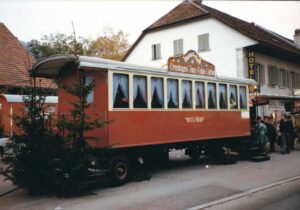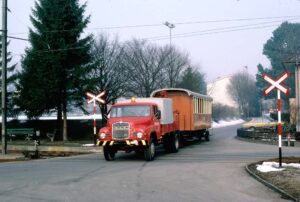
In 1907, the Langenthal – Jura – Bahn LJB opened the Langenthal – Niederbipp – Oensingen line. Since the passenger service was immediately well frequented, two additional two-axle passenger coaches C 23 and 24 were purchased just one year later in 1908. These were ordered by the LJB from the Schweizerische Wagons- und Aufzügefabrik AG Schlieren – Zürich SWS, unlike the original rolling stock, which was built by the Prague Waggonfabrik Ringhoffer and for the electric part by Alioth Münchenstein. The C 23 and 24 had a length of 9610 mm, a weight of 6.7 t and offered 30 seats.
The LJB and the Langenthal – Melchnau Bahn LMB merged in 1958 to form the OJB, where our coach was given the number B2 23.
The B2 23 and 24 were discarded in 1966 along with other coaches after the commissioning of the new shuttle trains Be 4/4 81 – 82 and Bt 101. The B2 23 stood next to the depot until 1973, when it was bought by a private person and thus escaped demolition.
Years later, my photo colleague Walter Ruetsch told me that the car was always set up as a coffee shop at the “Zibelemärit” in Oensingen in October.
As our group of “Bülachers” had already carried out a few photo trips on the OJB and SNB and, apart from the service vehicle X 92 (ex B2 16), there were no more two-axle passenger coaches, our interest was aroused. After contacting the owner, we were allowed to visit the coach. Our expectations were far exceeded. The coach was parked under a roof and presented itself in excellent condition. It was jacked up on one side on two screwed-on pneumatic wheels. The two original axles were unchanged on the coach and the plain bearing bushes were still filled with oil. Couplings and brake linkages were, as far as we could tell, completely present. Only most of the interior fittings were missing. Our goal was now clear: this coach must return to the OJB for a photo trip.
After a short hesitation, the owner agreed, under the condition that he would not be liable for anything.
Thanks to our long-standing contacts with the OJB, we were able to win the railway for a tour, which left equally positive impressions. We thus also got the OK from the OJB for the temporary return!
The next obstacle was to get the coach from Oensingen to Niederbipp. The owner was able to tell us that for the trip to the Zibelemärit, a lorry tow truck would put the side without the wheel on a mobile lifting jack and tow the coach there, similar to what you would do with a lorry. I contacted the contractor and he agreed, provided that the police also cooperated. The phone call with the police was very remarkable. They were caught off guard by a completely unfamiliar situation and I did not get an OK, but they assured me that there would be no patrols around during the time of our haul. I should choose a time with little traffic and inform them. Such a thing would be absolutely unthinkable in today’s regimented times!
On 16 March 1984, the time had come: the tow truck with crane, to our delight a beautiful old-timer MAN, was parked in front of the workshop in Oensingen and brought the B2 23 to light.
This story shows the transport to Langenthal. What happened to the coach during the photo excursion will perhaps follow in a later story…

March 16, 1984 Photo: Edi Meier, Bülach




This photo is from the return transport and was taken at Niederbipp, where the coach received its road equipment again, which is clearly visible. In the background next to the goods shed is the Be 4/4 80 (ex Biasca – Aquarossa ABe 4/4 5), which brought the coach from Langenthal to Niederbipp. October 10, 1984 Photo: Edi Meier, Bülach



To the regret of the OJB, the B2 23 coach was returned to the owner in Oensingen after the trip.
Werner Hardmeier restored and built further wooden benches on the still existing original frames with luggage racks with his pupils in the subject “handicrafts” according to the pattern of an original wooden bench. These were generously sanded, primed and repainted with silver paint. Last but not least, the racks were mounted again, so that the coach was once more originally equipped.
After the death of the owner, Walter Ruetsch was able to see the B2 23 at a farmer’s site in the Oensingen area.
Later it came to the railway museum at Kallnach, as a photo from October 16 2013 on Bahnbilder.de proves.
After this collection was dissolved, the coach was bought by Kleinbaan Service Kleinbaan Service in 2018 and brought to the Netherlands together with other vehicles from other railways, where it is considered as “parked”.
Back to railway stories.